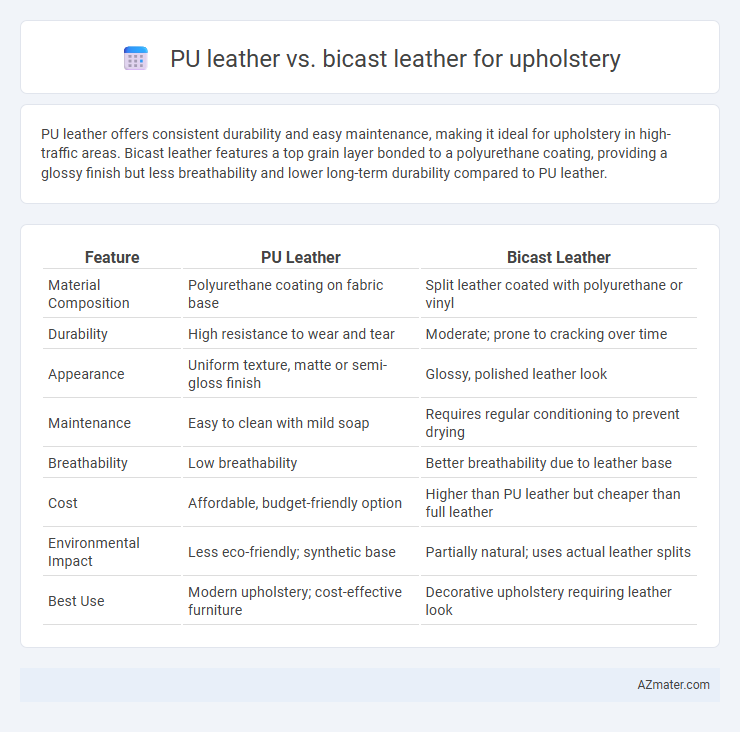PU leather offers consistent durability and easy maintenance, making it ideal for upholstery in high-traffic areas. Bicast leather features a top grain layer bonded to a polyurethane coating, providing a glossy finish but less breathability and lower long-term durability compared to PU leather.
Table of Comparison
| Feature | PU Leather | Bicast Leather |
|---|---|---|
| Material Composition | Polyurethane coating on fabric base | Split leather coated with polyurethane or vinyl |
| Durability | High resistance to wear and tear | Moderate; prone to cracking over time |
| Appearance | Uniform texture, matte or semi-gloss finish | Glossy, polished leather look |
| Maintenance | Easy to clean with mild soap | Requires regular conditioning to prevent drying |
| Breathability | Low breathability | Better breathability due to leather base |
| Cost | Affordable, budget-friendly option | Higher than PU leather but cheaper than full leather |
| Environmental Impact | Less eco-friendly; synthetic base | Partially natural; uses actual leather splits |
| Best Use | Modern upholstery; cost-effective furniture | Decorative upholstery requiring leather look |
Introduction to PU Leather and Bicast Leather
PU leather, or polyurethane leather, is a synthetic material made by coating a base fabric, typically polyester, with a flexible polyurethane layer that mimics the look and feel of genuine leather. Bicast leather consists of a split leather base coated with a layer of polyurethane or vinyl, combining real leather textures with enhanced surface durability. Both materials are commonly used in upholstery due to their cost-effectiveness, ease of maintenance, and resistance to stains and wear.
What is PU Leather?
PU leather, or polyurethane leather, is a synthetic material made by coating a base fabric, typically polyester, with a layer of polyurethane to mimic the look and feel of genuine leather. It offers durability, ease of cleaning, and resistance to cracking or peeling, making it a popular choice for upholstery. Unlike bicast leather, which uses a split leather base bonded with polyurethane, PU leather is entirely synthetic, providing a more uniform texture and greater customization in color and finish.
Understanding Bicast Leather
Bicast leather is made by applying a polyurethane (PU) coating over a split leather base, combining natural leather's texture with synthetic durability. This construction offers a glossy finish and enhanced resistance to stains and scratches, making it suitable for upholstery in high-traffic areas. Unlike pure PU leather, bicast leather retains some natural leather fibers, providing a balance between authenticity and ease of maintenance.
Manufacturing Process: PU vs Bicast Leather
PU leather is crafted by coating a fabric base with a flexible polyurethane layer, resulting in a durable and breathable material ideal for upholstery applications. Bicast leather involves a split leather backing topped with a thick polyurethane coating, giving it a glossy finish but reducing breathability and flexibility compared to pure PU leather. The manufacturing process of PU leather emphasizes uniformity and resistance, while Bicast leather prioritizes appearance through its composite layered structure.
Durability and Longevity Comparison
PU leather offers superior durability due to its uniform synthetic coating that resists cracking and peeling over time, making it ideal for high-traffic upholstery applications. Bicast leather, which combines a split leather base with a polyurethane coating, tends to be less durable as the polyurethane layer can wear off, exposing the less resilient split leather underneath. When comparing longevity, PU leather maintains its appearance and structural integrity longer than bicast leather, which often shows signs of wear and degradation more quickly.
Aesthetics and Texture Differences
PU leather features a consistent grain and smooth surface, offering a uniform, sleek aesthetic ideal for modern upholstery designs. Bicast leather combines a split leather base with a polyurethane topcoat, resulting in a glossier finish but a less natural texture compared to PU leather. The texture of bicast leather tends to be stiffer and more plastic-like, while PU leather provides a softer, more flexible feel that closely mimics genuine leather.
Comfort Level in Upholstery Applications
PU leather offers a softer and more flexible surface, enhancing comfort in upholstery applications with better breathability and cushioning. Bicast leather, made by coating split leather with a polyurethane layer, tends to be stiffer and less breathable, which can reduce comfort during extended use. Choosing PU leather improves comfort levels in furniture due to its pliability and moisture-wicking properties that help maintain temperature regulation.
Maintenance and Cleaning Requirements
PU leather for upholstery offers superior ease of maintenance with its water-resistant surface that requires only a damp cloth for routine cleaning, making it ideal for high-traffic areas. Bicast leather, made from split leather with a polymer coating, demands more careful attention to avoid damage to the glossy finish and often requires specialized leather cleaners and conditioners to preserve appearance and prevent cracking. Both materials benefit from regular dusting, but PU leather's durability and resistance to stains provide a more user-friendly option for simple upkeep and longevity.
Cost Comparison: PU Leather vs Bicast Leather
PU leather generally offers a more affordable option for upholstery compared to bicast leather due to its synthetic composition and easier manufacturing process. Bicast leather, made from split leather coated with polyurethane, often carries a higher price because of its partial genuine leather content and enhanced durability. Budget-conscious buyers seeking cost-effective solutions typically prefer PU leather, while those willing to invest more may choose bicast leather for its leather-like appearance and resilience.
Eco-Friendliness and Sustainability Factors
PU leather offers greater eco-friendliness compared to bicast leather due to its synthetic composition, which avoids the heavy use of animal hides and reduces waste. Bicast leather, made by laminating a thin layer of genuine leather with a polyurethane coating, involves more resource-intensive leather processing and generates more chemical waste. Choosing PU leather for upholstery supports sustainability by minimizing environmental impact and promoting the use of more recyclable materials.

Infographic: PU leather vs Bicast leather for Upholstery
 azmater.com
azmater.com